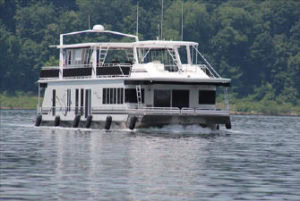 As houseboats age, we are seeing more cases of roofs that have taken on large amounts of moisture for a prolonged period of time. Before the owner begins to suspect a problem, the damage has been done. In some cases, many 4′ x 8′ sheets of plywood, and roof supports have to be replaced, to bring the roof back up to strength. It only takes a small hole to allow the water in, and once inside it can travel from roof support to roof support, and even down the side walls.
As houseboats age, we are seeing more cases of roofs that have taken on large amounts of moisture for a prolonged period of time. Before the owner begins to suspect a problem, the damage has been done. In some cases, many 4′ x 8′ sheets of plywood, and roof supports have to be replaced, to bring the roof back up to strength. It only takes a small hole to allow the water in, and once inside it can travel from roof support to roof support, and even down the side walls.
Check all roof rail supports where screws are attached. Make sure caulk is completely sealed, and screws have not begun to back out. Also check around flybridge and roof bar mounts. Don’t just trust your eyes to inspect. Use your foot to step along all support areas, checking for any sign of weak areas. You will hear a cracking sound, and feel soft spots. Inspect around windows, checking for loose caulk, and soft areas in side walls. If you see any signs of “delamination” (the gel coat pulling away from the wood) you have moisture getting in somewhere. Check bottom of cabin walls and make sure there are no gaps in caulk between trim and wall. The plastic dryer vent mounted on the outside cabin can become brittle, and begin disintegrating. Check it’s integrity, and the caulk that surrounds it. This is an easy water entry point if not in good condition. (Don’t ask me how I know).
You should also crawl along port and starboard sides of hull, shining a flashlight along floor supports, and plywood, looking for any signs of dark discoloration in the wood. It’s better to find a small leak now, than walk into your boat in the spring and smell a damp musty smell.
 As houseboats age, we are seeing more cases of roofs that have taken on large amounts of moisture for a prolonged period of time. Before the owner begins to suspect a problem, the damage has been done. In some cases, many 4′ x 8′ sheets of plywood, and roof supports have to be replaced, to bring the roof back up to strength. It only takes a small hole to allow the water in, and once inside it can travel from roof support to roof support, and even down the side walls.
As houseboats age, we are seeing more cases of roofs that have taken on large amounts of moisture for a prolonged period of time. Before the owner begins to suspect a problem, the damage has been done. In some cases, many 4′ x 8′ sheets of plywood, and roof supports have to be replaced, to bring the roof back up to strength. It only takes a small hole to allow the water in, and once inside it can travel from roof support to roof support, and even down the side walls.

